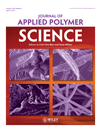A novel route for synthesis of temperature responsive nanoparticles
Abstract
We report the preparation of responsive silica nanoparticles by reaction of epoxy modified silica with stimuli responsive poly (acrylic acid-N-isopropylacrylamide) (poly (AA-co-NIPAAm)). A series of copolymers of poly (AA-co-NIPAAm) were synthesized by a novel route, employing solid state condensation of polyacrylic acid and isopropyl amine in different feed ratios (44 mol %–100 mol % AA). The structure of the copolymers was characterized by FT-IR, 1H-NMR. The lower critical solution temperature (LCST) was found to vary with the copolymer composition. The pH dependence of the LCST was also observed, and the copolymers exhibited a higher LCST at neutral pH than at acidic pH (4–5). Selected copolymers were used to prepare responsive core-shell particles. Silica nanoparticles modified using glycidoxy propyl trimethoxy propyl silane were reacted with the responsive copolymer to form responsive core-shell particles. The influence of reaction conditions on the modification of silica particles and reaction with responsive copolymers was investigated. The hydrodynamic behavior of the synthesized thermo responsive nanoparticles was also studied. © 2010 Wiley Periodicals, Inc. J Appl Polym Sci, 2011




